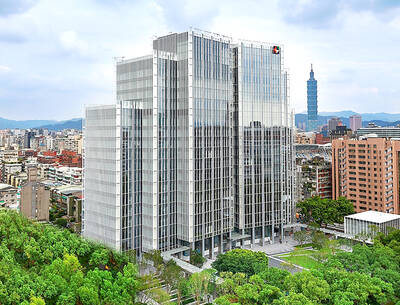Taiwan expects to add more than 1 gigawatt of renewable energy capacity this year, the Bureau of Energy said yesterday.
Three new offshore wind farms are slated for completion or partial operation this year, which would contribute more than 800 megawatts, while a major solar project on Taiwan Sugar Co’s (Taisugar, 台糖) land due to begin operations this year would account for 181 megawatts.
The COVID-19 crisis caused significant delays in renewable energy construction last year, Bureau of Energy section head Chen Chung-hsien (陳崇憲) said.
“Solar as well as offshore wind farms were affected,” Chen said. “With offshore wind farms, it was far more difficult to mobilize the construction boats due to the crisis.”
German energy group Wpd’s 640MW Yunlin offshore wind farm is slated to be partially completed this year, with more than 400MW to come online, Chen said. Meanwhile, Formosa 2 OWF off the shore of Miaoli, codeveloped by a Japanese-Australian-Taiwanese consortium, is due to be wholly developed, bringing 376MW of renewable energy capacity. Lastly, Taipower Power Co’s (Taipower, 台電) 110MW Changhua Wind Farm is scheduled to be completed this year. Currently, there is only one wind farm in operation, the 128 MW Formosa 1 off the coast of Miaoli.
The Ministry of Economic Affairs is expected to announce rules for “phase three” of the offshore wind farm development in the first quarter. Phase three is expected to release 10GW worth of projects between 2026 and 2035.
A solar farm with installed capacity of 181MW built on the state-owned Taisugar’s land on the salt fields of Tainan’s Cigu District (七股) is to begin operations later this year, as is a solar project incorporating aquaculture. There will be more joint aquaculture-solar projects to come after the 40MW pilot project in Chiayi, the energy bureau said.
After a controversial Council of Agriculture decision in July last year to limit solar farms on agricultural land and curb joint solar-agriculture projects, the Ministry of Economic Affairs has encouraged solar-aquaculture projects and multi-land-use solar farms to try to meet the government’s quota for total solar capacity, which was missed last year. The original goal for total solar capacity was 6.5GW by the end of last year, however, only 5.82 GW was reached. The goal for the end of this year will be 8.75GW.
By 2025, the Ministry of Economic Affairs aims to generate 20 percent of Taiwan’s energy through renewable means, including 20GW of solar and more than 5.7GW from offshore wind farms.

UNCERTAINTY: Investors remain worried that trade negotiations with Washington could go poorly, given Trump’s inconsistency on tariffs in his second term, experts said The consumer confidence index this month fell for a ninth consecutive month to its lowest level in 13 months, as global trade uncertainties and tariff risks cloud Taiwan’s economic outlook, a survey released yesterday by National Central University found. The biggest decline came from the timing for stock investments, which plunged 11.82 points to 26.82, underscoring bleak investor confidence, it said. “Although the TAIEX reclaimed the 21,000-point mark after the US and China agreed to bury the hatchet for 90 days, investors remain worried that the situation would turn sour later,” said Dachrahn Wu (吳大任), director of the university’s Research Center for

Alchip Technologies Ltd (世芯), an application-specific integrated circuit (ASIC) designer specializing in artificial-intelligence (AI) chips, yesterday said that small-volume production of 3-nanometer (nm) chips for a key customer is on track to start by the end of this year, dismissing speculation about delays in producing advanced chips. As Alchip is transitioning from 7-nanometer and 5-nanometer process technology to 3 nanometers, investors and shareholders have been closely monitoring whether the company is navigating through such transition smoothly. “We are proceeding well in [building] this generation [of chips]. It appears to me that no revision will be required. We have achieved success in designing

PROJECTION: KGI Financial said that based on its foreign exchange exposure, a NT$0.1 increase in the New Taiwan dollar would negatively impact it by about NT$1.7 billion KGI Financial Holding Co (凱基金控) yesterday said its life insurance arm has increased hedging and adopted other moves to curb the impact of the local currency’s appreciation on its profitability. “It is difficult to accurately depict the hedging costs, which might vary from 7 percent to 40 percent in a single day,” KGI Life Insurance Co (凱基人壽) told an investors’ conference in Taipei. KGI Life, which underpinned 66 percent of the group’s total net income last year, has elevated hedging to 55 to 60 percent, while using a basket of currencies to manage currency volatility, the insurer said. As different

Taiwanese insurers are facing difficult questions about the damage of recent swings in the New Taiwan dollar. Regulators might have a partial solution: letting firms change how they calculate the value of foreign currency assets. The Financial Supervisory Commission (FSC) is considering allowing insurers to use six-month average exchange rates when they calculate risk-based capital in their semiannual reports, a shift from the current system where insurers use exchange rates on the final day of reporting. The change could ease pressure on the US$1.2 trillion insurance sector, whose huge exposure to foreign assets came into the spotlight earlier this month after a